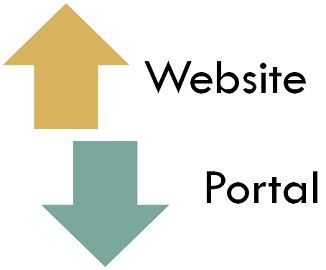 Website and Portal are distinct terms, but there exists a correlation between the two. Website and portal both have a web-based interface; a website is the collection of web pages whereas a portal acts as a gateway to world wide web and provides many services.
Website and Portal are distinct terms, but there exists a correlation between the two. Website and portal both have a web-based interface; a website is the collection of web pages whereas a portal acts as a gateway to world wide web and provides many services.
An organisation owns a website. On the other hand, A portal is user-centric which means a user can probably provide information and data.
Content: Website and Portal
Comparison Chart
| Basis for comparison | Website | Portal |
|---|---|---|
| Basic | It is a location on the internet usually accessed through an URL. | It provides a single point of access where the traffic is limited to the right set of users. |
| Features | Owned by an organization. | User-centric. |
| Interaction | User can not interact with a website. | There is a two-way communication between user and portal. |
| Property | Not necessarily a knowledge domain. | Act as the gateway to the specific knowledge domain. |
| Management | Seldom updation of the information sources. | Regular updation of information sources. |
Definition of Website
A website is the group of web pages which are placed in a location on the internet and accessed through a web address. Content on a website is globally visible, publically used, remains same for the different individuals. Users need not to login for accessing the website. The user can perform any specific task, and the website supports it.
A website could be industry-specific, product specific or services specific etc.; these websites are intended to educate their site visitors about their industry, products or services information. There is no use of a personalized database, and the website does not usually reference it.
Definition of Portal
A web portal is a typical knowledge management system that delivers the facility for organisation or companies to build, share, interchange and reuse knowledge. It is the private location on the internet retrieved through a unique URL (web address), and probably login id and password. Web portal content is login protected and user specific and its interface could be public and private.
It allows access to multiple user roles. Contents in a web portal are dynamic and changed frequently. The visibility of one content changes from person to person which means a content could be unique to a user based on group member settings. Contents are collected from the different and diverse sources.
Portals can be divided into two classes: Horizontal portals (Horizontal Enterprise Portals) and vertical portals (Vertical Enterprise Portals).
- Horizontal portals are analogous to a public website which tries to deliver every type of service that its users may need.
- Vertical portals work in a user-centric manner and deliver information that is organization-specific.
Key Differences Between Website and Portal
- A website is a set of interlinked web pages hosted from the same domain, which can be accessed through a web address. As against a portal is a custom-made website which involves information from a broad class of sources in a persistent manner.
- A portal is usually user-centric whereas a website is owned by an organization or company etc.
- There is no intercommunication between the website and the user. On the contrary, a user can interact with the portal.
- A website is not a primary knowledge domain whereas portal is the passage to knowledge management system.
- The information is regularly updated in case of a portal. In contrast, the information sources in a website are rarely updated.
Conclusion
A website and portal are differentiated on the basis of personalized information, and quick access where a portal renders personalized information to users and website is not intended to function in that way.
Surjeet says
Very interesting post. I found so many interesting stuff in your blog.
Thanks for the post.